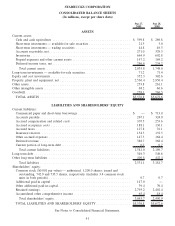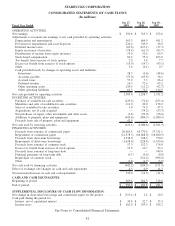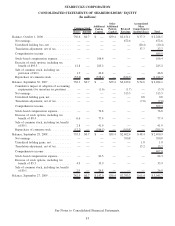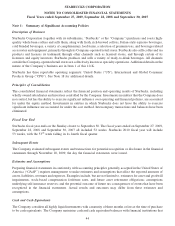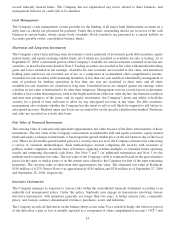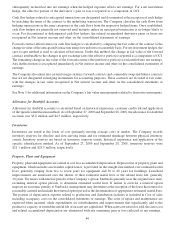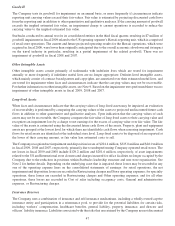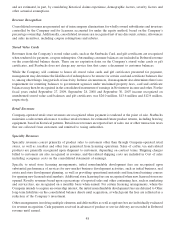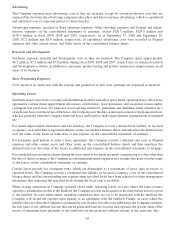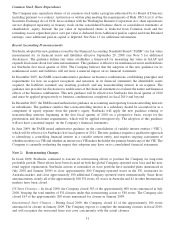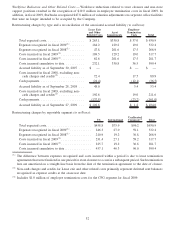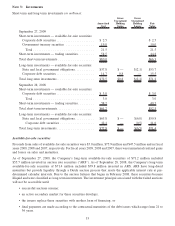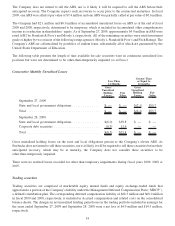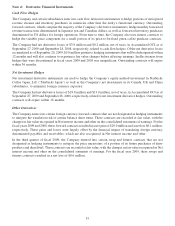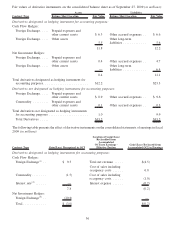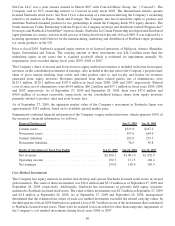Starbucks 2009 Annual Report Download - page 58
Download and view the complete annual report
Please find page 58 of the 2009 Starbucks annual report below. You can navigate through the pages in the report by either clicking on the pages listed below, or by using the keyword search tool below to find specific information within the annual report.Asset Retirement Obligations
Starbucks recognizes a liability for the fair value of required asset retirement obligations (“ARO”) when such
obligations are incurred. The Company’s AROs are primarily associated with leasehold improvements which, at the
end of a lease, the Company is contractually obligated to remove in order to comply with the lease agreement. At the
inception of a lease with such conditions, the Company records an AROliability and a corresponding capital asset in
an amount equal to the estimated fair value of the obligation. The liability is estimated based on a number of
assumptions requiring management’s judgment, including store closing costs, cost inflation rates and discount
rates, and is accreted to its projected future value over time. The capitalized asset is depreciated using the
convention for depreciation of leasehold improvement assets. Upon satisfaction of the ARO conditions, any
difference between the recorded AROliability and the actual retirement costs incurred is recognized as an operating
gain or loss in the consolidated statements of earnings. As of September 27, 2009 and September 28, 2008, the
Company’s net ARO asset included in Net property, plant and equipment was $15.1 million and $18.5 million,
respectively, while the Company’s net ARO liability included in Other long-term liabilities was $43.4 million and
$44.6 million, as of the same respective dates.
Stock-based Compensation
The Company maintains several equity incentive plans under which it may grant non-qualified stock options,
incentive stock options, restricted stock, restricted stock units (“RSUs”) or stock appreciation rights to employees,
non-employee directors and consultants. The Company also has employee stock purchase plans (“ESPP”). RSUs
issued by the Company are equivalent to nonvested shares under the applicable accounting guidance. See Note 14
for additional details.
Foreign Currency Translation
The Company’s international operations generally use their local currency as their functional currency. Assets and
liabilities are translated at exchange rates in effect at the balance sheet date. Income and expense accounts are
translated at the average monthly exchange rates during the year. Resulting translation adjustments are recorded as a
component of Accumulated other comprehensive income on the consolidated balance sheets.
Income Taxes
The Company computes income taxes using the asset and liability method, under which deferred income taxes are
provided for the temporary differences between the financial statement carrying amounts and the tax basis of the
Company’s assets and liabilities. The Company will establish a valuation allowance for deferred tax assets if it is
more likely than not that these items will either expire before the Company is able to realize their benefits, or that
future deductibility is uncertain. Periodically, the valuation allowance is reviewed and adjusted based on
management’s assessments of realizable deferred tax assets.
Starbucks adopted the new accounting requirements for uncertain tax positions on the first day of the Company’s
first fiscal quarter of 2008. The cumulative impact of adopting the new accounting requirements is shown in the
consolidated statements of shareholders’ equity. The Company recognizes the tax benefit from an uncertain tax
position only if it is more likely than not that the tax position will be sustained on examination by the taxing
authorities, based on the technical merits of the position. The tax benefits recognized in the financial statements
from such a position are measured based on the largest benefit that has a greater than 50% likelihood of being
realized upon ultimate settlement. The Company recognizes interest and penalties related to income tax matters in
income tax expense. See Note 15 for additional details.
Earnings per Share
Basic earnings per share is computed on the basis of the weighted average number of shares and common stock units
that were outstanding during the period. Diluted earnings per share includes the dilutive effect of common stock
equivalents consisting of certain shares subject to stock options and RSUs, using the treasury stock method.
Performance-based RSUs are considered diluted when the related performance criterion has been met.
50



